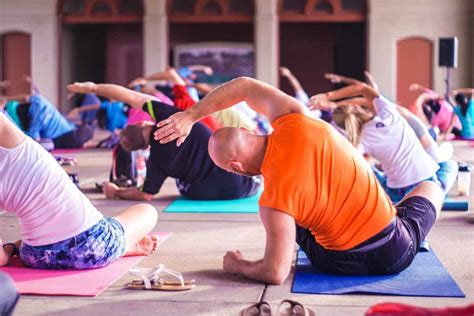Surprising Facts About Yoga: Uncovering the Depth of an Ancient Practice
Yoga, often viewed as a peaceful form of exercise, carries layers of surprising benefits, challenges, and misconceptions that extend far beyond the mat. While many see it as a way to improve flexibility and reduce stress, yoga’s true influence spans history, physical and mental health, societal trends, and even future innovations. Whether you’re a seasoned yogi or a curious beginner, this comprehensive guide dives into unexpected facts, offering a new perspective on this ancient practice.
Introduction
Yoga’s popularity has exploded worldwide, transforming from an ancient Indian spiritual discipline into a multi-billion-dollar global industry. Yet, beyond the basic understanding of poses and breathwork, there lies a complex web of facts, misconceptions, and evolving applications. What if we told you that yoga is about much more than flexibility or mindfulness? This article delves into surprising facts about yoga, its origins, practical applications, and future directions. Whether you’re just starting or have practiced for years, this guide will reshape how you see yoga.
Key Concepts
Understanding yoga means grasping its fundamental principles and how they manifest in practice. Let’s explore a few critical concepts:
- Asanas: These are the physical postures of yoga, often the most visible aspect. Each asana is designed not only to improve flexibility but also to enhance mental focus and stability.
- Pranayama: Breath control techniques are integral to regulating energy and calming the nervous system.
- Bandhas: These are energy locks within the body that help direct and control the flow of life force or prana.
- Yoga Sutras of Patanjali: This ancient text forms the philosophical backbone of yoga, offering insights into its ethical and spiritual dimensions.
- Kundalini: The concept of a dormant energy located at the base of the spine, which can be awakened through yoga practice.
Historical Context
Yoga’s roots stretch back over 5,000 years to the Indus Valley Civilization. What started as a deeply spiritual practice intended to unify the body, mind, and spirit has since evolved into a global phenomenon. The history of yoga can be divided into four broad periods:
| Period | Key Developments |
|---|---|
| Pre-Classical Yoga | The origins of yoga are found in the Vedas, ancient Indian scriptures. The earliest forms of yoga focused on sacrifice and ritual. |
| Classical Yoga | Patanjali’s Yoga Sutras, written around 200 BCE, formalized the eight limbs of yoga, emphasizing mental discipline and ethical practices. |
| Post-Classical Yoga | Here, the emphasis shifted towards developing the body through asanas to help reach spiritual enlightenment. |
| Modern Yoga | In the 20th century, yoga entered the West, led by figures like T. Krishnamacharya. Today, yoga is recognized for its fitness, mental health, and therapeutic benefits. |
Current State Analysis
Today, yoga has become synonymous with wellness and self-care, but its modern adaptations often strip it of deeper philosophical roots. The commercial yoga industry is vast, with numerous styles from Vinyasa and Hot Yoga to Iyengar and Yin. With this expansion has come increased popularity, yet many are unaware of yoga’s original purpose.
Challenges today include:
- Over-commercialization: Yoga has become a profitable industry, sometimes sidelining its traditional spiritual teachings.
- Cultural appropriation concerns: Some practitioners and scholars argue that yoga’s Western transformation lacks respect for its cultural origins.
- Fragmentation of styles: There are now hundreds of yoga styles, each with differing interpretations of what yoga should be.
Despite these issues, yoga remains highly valued for its physical, mental, and emotional benefits, supported by growing scientific evidence.
Practical Applications
Yoga has practical benefits beyond flexibility. It can improve overall wellness in a variety of ways:
- Physical health: Yoga is well-known for enhancing flexibility, but it also increases strength, balance, and cardiovascular health.
- Mental health: Regular practice helps reduce anxiety, depression, and stress through mindfulness and breathing techniques.
- Workplace productivity: More companies are offering yoga sessions for employees to enhance focus and reduce burnout.
- Yoga for trauma: Therapeutic yoga can help people suffering from PTSD or trauma by grounding them and offering body-mind reconnection.
Case Studies
Yoga’s effectiveness is highlighted in various case studies. Here are some notable examples:
| Case Study | Findings |
|---|---|
| Yoga for Veterans | Studies show that yoga reduces PTSD symptoms and improves sleep among veterans. |
| Corporate Yoga Programs | Companies with regular yoga programs report higher employee satisfaction and lower absenteeism. |
| Yoga in Schools | Introducing yoga in schools has helped students manage anxiety and improve concentration and emotional regulation. |
Stakeholder Analysis
Understanding yoga’s broad stakeholder landscape can help address its global impact:
- Teachers: Responsible for transmitting authentic yoga teachings and practices.
- Students: With varied needs and goals, students play a key role in shaping yoga’s future directions.
- Yoga Studios: Balancing profitability and authentic practices is a challenge for studios, particularly in the West.
- Regulatory Bodies: Certification organizations like the Yoga Alliance aim to maintain quality standards, though they are often criticized for inadequacies.
- Healthcare Providers: Yoga’s potential to support physical and mental health positions it as a complementary treatment method in healthcare.
Implementation Guidelines
For those looking to integrate yoga more deeply into their lives or communities, consider the following implementation strategies:
- Set Clear Goals: Whether for personal growth or physical health, clarity on what you want to achieve is crucial.
- Find the Right Style: With so many yoga styles, choosing one that aligns with your objectives is vital.
- Consistent Practice: Commit to a regular schedule. Yoga’s benefits accumulate over time, with consistency key to improvement.
- Respect Tradition: While modern adaptations are inevitable, it’s important to remain respectful of yoga’s roots and principles.
- Seek Qualified Teachers: Ensure instructors have appropriate certifications and a deep understanding of both the physical and spiritual aspects of yoga.
Ethical Considerations
Yoga raises several ethical questions, particularly in its modern context:
- Cultural Appropriation: Is the Westernized version of yoga respectful of its Indian roots? How can we honor its history while making it accessible?
- Instructor Responsibility: Instructors must balance helping students reach their physical limits while avoiding injury.
- Inclusivity: Is yoga accessible to all, regardless of body type, race, gender, or socioeconomic status?
Limitations and Future Research
Although yoga has gained significant scientific backing, there are areas where further research is needed:
- Long-term impacts: While short-term benefits are well-documented, more studies are needed on yoga’s long-term effects on mental and physical health.
- Yoga for specific populations: How effective is yoga for certain populations, such as the elderly or those with disabilities?
- Yoga in combination with other treatments: More research is needed on how yoga interacts with other treatments, especially in mental health care.
Yoga continues to evolve, and future research will likely explore its application in new areas, from mental health therapies to workplace productivity enhancements.
Expert Commentary
While yoga may seem simple, its depth is profound. Experts agree that understanding yoga requires acknowledging its physical, mental, and spiritual aspects. But the modern transformation of yoga poses a challenge: How do we balance its ancient roots with the demands of contemporary society?
As we move forward, the future of yoga lies in its ability to adapt while staying true to its core principles. This balance will ensure yoga remains a holistic practice that benefits all who engage with it, whether for health, peace of mind, or personal growth.








